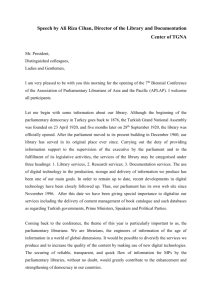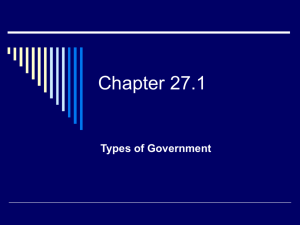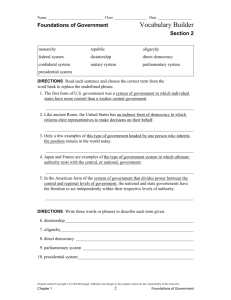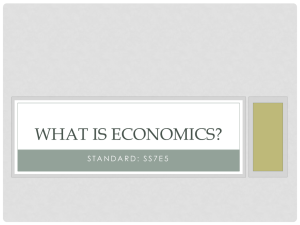Parliamentary System
advertisement
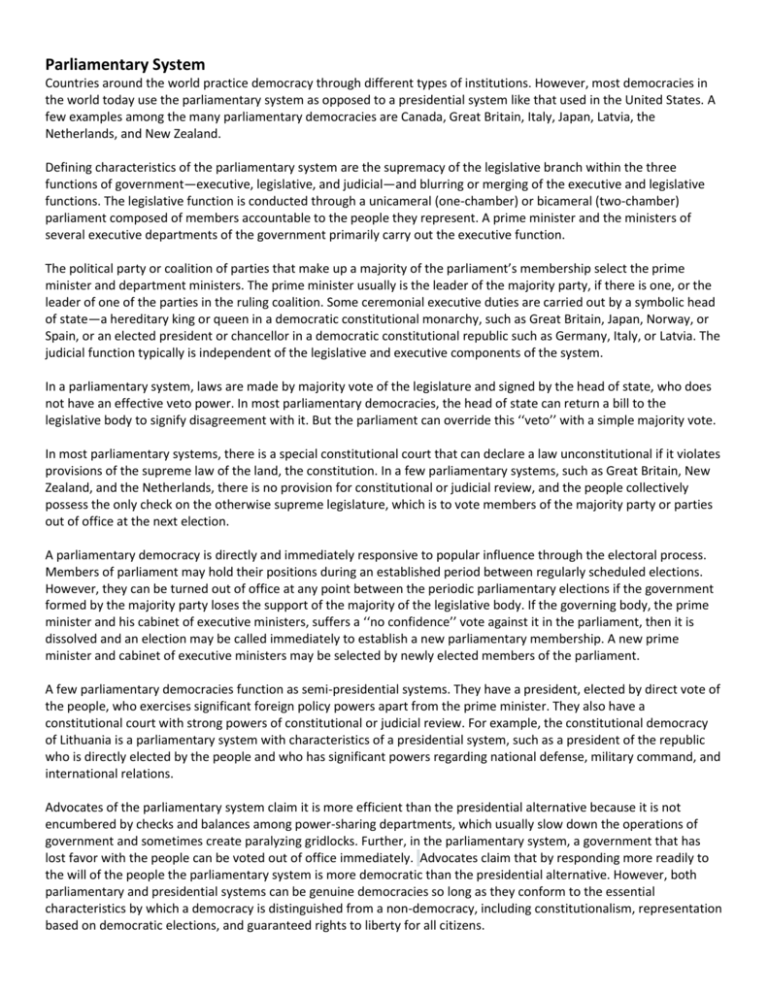
Parliamentary System Countries around the world practice democracy through different types of institutions. However, most democracies in the world today use the parliamentary system as opposed to a presidential system like that used in the United States. A few examples among the many parliamentary democracies are Canada, Great Britain, Italy, Japan, Latvia, the Netherlands, and New Zealand. Defining characteristics of the parliamentary system are the supremacy of the legislative branch within the three functions of government—executive, legislative, and judicial—and blurring or merging of the executive and legislative functions. The legislative function is conducted through a unicameral (one-chamber) or bicameral (two-chamber) parliament composed of members accountable to the people they represent. A prime minister and the ministers of several executive departments of the government primarily carry out the executive function. The political party or coalition of parties that make up a majority of the parliament’s membership select the prime minister and department ministers. The prime minister usually is the leader of the majority party, if there is one, or the leader of one of the parties in the ruling coalition. Some ceremonial executive duties are carried out by a symbolic head of state—a hereditary king or queen in a democratic constitutional monarchy, such as Great Britain, Japan, Norway, or Spain, or an elected president or chancellor in a democratic constitutional republic such as Germany, Italy, or Latvia. The judicial function typically is independent of the legislative and executive components of the system. In a parliamentary system, laws are made by majority vote of the legislature and signed by the head of state, who does not have an effective veto power. In most parliamentary democracies, the head of state can return a bill to the legislative body to signify disagreement with it. But the parliament can override this ‘‘veto’’ with a simple majority vote. In most parliamentary systems, there is a special constitutional court that can declare a law unconstitutional if it violates provisions of the supreme law of the land, the constitution. In a few parliamentary systems, such as Great Britain, New Zealand, and the Netherlands, there is no provision for constitutional or judicial review, and the people collectively possess the only check on the otherwise supreme legislature, which is to vote members of the majority party or parties out of office at the next election. A parliamentary democracy is directly and immediately responsive to popular influence through the electoral process. Members of parliament may hold their positions during an established period between regularly scheduled elections. However, they can be turned out of office at any point between the periodic parliamentary elections if the government formed by the majority party loses the support of the majority of the legislative body. If the governing body, the prime minister and his cabinet of executive ministers, suffers a ‘‘no confidence’’ vote against it in the parliament, then it is dissolved and an election may be called immediately to establish a new parliamentary membership. A new prime minister and cabinet of executive ministers may be selected by newly elected members of the parliament. A few parliamentary democracies function as semi-presidential systems. They have a president, elected by direct vote of the people, who exercises significant foreign policy powers apart from the prime minister. They also have a constitutional court with strong powers of constitutional or judicial review. For example, the constitutional democracy of Lithuania is a parliamentary system with characteristics of a presidential system, such as a president of the republic who is directly elected by the people and who has significant powers regarding national defense, military command, and international relations. Advocates of the parliamentary system claim it is more efficient than the presidential alternative because it is not encumbered by checks and balances among power-sharing departments, which usually slow down the operations of government and sometimes create paralyzing gridlocks. Further, in the parliamentary system, a government that has lost favor with the people can be voted out of office immediately. Advocates claim that by responding more readily to the will of the people the parliamentary system is more democratic than the presidential alternative. However, both parliamentary and presidential systems can be genuine democracies so long as they conform to the essential characteristics by which a democracy is distinguished from a non-democracy, including constitutionalism, representation based on democratic elections, and guaranteed rights to liberty for all citizens. Parliamentary VS Presidential System Posters Create a poster demonstrating the differences between parliamentary and presidential systems. Required Topics Executives Legislatures Political Parties Elections On Back – Paragraph Which system is preferable – a parliamentary or presidential? Why? Grading 20 = 5 points for each topic 5 points for neatness & color 15 points for paragraph 40 Points Total

